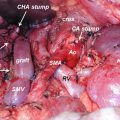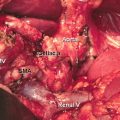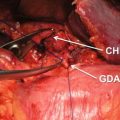T1DM
T2DM
Pancreatogenic DM
Hormone levels
Insulin
Low
High
Low/absent
Glucagon
Normal/high
Normal/high
Low/absent
Pancreatic polypeptide
Normal/low (late)
High
Low
Insulin sensitivity
Peripheral
Normal/high
Low
High
Hepatic
Normal
Normal/low
Low
Clinical features
Hyperglycemia
Severe
Usually mild
Mild
Hypoglycemic episodes
Common
Rare
Common
Ketoacidosis episodes
Common
Rare
Rare
However, post-pancreatectomy DM is not always associated with poor glycemic control. The derangements in glucose metabolism after pancreatectomy range from mild impairments to severe impairments characterized by frequent episodes of hypoglycemia, depending on the extent of resection and the underlying pancreatic disease. Up to 25% of patients with post-pancreatectomy DM have severe glucose metabolic abnormalities [36]. The number of metabolic abnormalities increases greatly as the extent of pancreatectomy increases. In addition, the manifestation of glucose metabolic abnormalities after pancreatectomy may be determined by the relative deficiencies of insulin, glucagon, and PP according to the extent and region of resection. Resection of the pancreatic head is more likely to result in PP deficiency together with hepatic insulin resistance and fasting hyperglycemia. Resection of the distal pancreas is likely to result in glucagon deficiency and a high risk of hypoglycemia [40].
34.3 Prevalence of Post-pancreatectomy DM
In the past, the incidence of DM after partial pancreatectomy has been underestimated. It was though that DM develops if more than 80% of a normal pancreas or 50% of a diseased pancreas are resected. However, recent studies have shown that DM might occur more frequently after partial pancreatectomy than was originally believed, suggesting that this post-pancreatectomy DM might be underestimated and underappreciated [36]. While total pancreatectomy causes pancreatogenic DM in all cases, the incidence of DM after partial pancreatectomy varies according to the underlying pancreatic disease, the type of surgery, and the extent of resection [12, 40].
34.3.1 Prevalence of DM After Pancreatoduodenectomy
There are limited data on the incidence of DM after pancreatoduodenectomy in patients with benign or malignant tumors. Fewer patients (18–27%) without preoperative DM develop DM after pancreatic resection for benign or malignant pancreatic tumors compared with patients with chronic pancreatitis [22, 32]. The impact of the anastomotic method on postoperative endocrine function is controversial. Although patients who underwent pancreaticogastrostomy experienced marked pancreatic exocrine insufficiency, the extent of impaired endocrine function was similar to that in patients who underwent pancreaticojejunostomy [13, 37]. The decline in glucose tolerance after pancreatoduodenectomy is apparently dependent on a low endocrine functional reserve of the remnant pancreas rather than the anastomotic procedures.
34.3.2 Prevalence of DM After Distal Pancreatectomy
Distal pancreatectomy involves the resection of the pancreatic body and tail, and the volume of resection is dependent on tumor location. The incidence of DM after distal pancreatectomy ranged from 5% to 42% in previous studies [8, 22]. A recent systematic review revealed that, after distal pancreatectomy for benign or malignant tumors, the cumulative incidence of DM was 14%, which is significantly lower than the corresponding value of 39% in patients with chronic pancreatitis [8]. However, a specific limitation of interpreting the results of previous studies is that the volume of the resected pancreas varied considerably, ranging from 10% to 90%, or was not specified. This may contribute to the varying incidence of DM. Recently Kang et al. [15] reported that resection of more than 25% of the total pancreas volume was a significant and independent risk factor for impaired endocrine function after distal pancreatectomy. They also showed that the percentage of patients with impaired endocrine function increased with increasing resection volume. These results suggest that clinicians should recognize the risk of DM, especially in patients with pancreatic cancer who require resection of a greater volume of the pancreas parenchyma for oncologic safety.
Most of the previous epidemiologic studies on the incidence of DM after pancreatectomy have several limitations, which included (1) a retrospective design; (2) heterogeneous criteria for establishing DM without biochemical criteria; (3) no information on preoperative glucose metabolism, such as impaired glucose tolerance or undetected DM; and (4) different follow-up times. Therefore, a prospective observational study with strict diagnostic criteria is needed to estimate the incidence of DM developing after pancreatectomy.
34.4 Special Considerations in the Treatment of Post-pancreatectomy DM
34.4.1 Treatment Guidelines
Limited data are available to guide the development of treatment guidelines specific to pancreatogenic DM, especially post-pancreatectomy DM. Thus, despite its distinct features to those of T1DM and T2DM, post-pancreatectomy DM is often treated according to the best practice recommendations for T1DM and T2DM [24, 27]. The primary target of the treatment of post-pancreatectomy DM, like T1DM and T2DM, is to maintain hemoglobin (Hb)A1c at <7% in order to minimize the risk of microvascular and macrovascular complications [7, 34]. This is because the risks of long-term DM-related complications in patients with T3cDM are similar to those in patients with T1DM and T2DM [5, 43].
In all patients with post-pancreatectomy DM, the initial treatment should begin with efforts to correct the lifestyle factors that contribute to hyperglycemia and to minimize the risk of hypoglycemia. Weight loss in obese patients, daily exercise, low-carbohydrate diet, abstinence from alcohol, and smoking cessation should be encouraged [7]. The therapeutic agents typically used for the treatment for DM after pancreatectomy are the same as those used for T2DM. The choice between insulin or non-insulin drugs as initial therapy depends on the patient’s clinical presentation [7, 27]. Insulin is usually preferred for patients with severe hyperglycemia. Because patients with post-pancreatectomy DM show enhanced peripheral sensitivity to insulin, the dose of insulin required to achieve and maintain glycemic control may be significantly less than that required by other insulin-dependent patients. For patients without severe hyperglycemia, orally administered drugs can be initiated. Metformin is commonly used as the initial oral drug. If hyperglycemia is not well controlled, other orally administered drugs such as a thiazolidinedione or an α-glucosidase inhibitor can be added to metformin. Sulfonylureas and incretin-based drugs (GLP-1 analogs and DPP-4 inhibitors) should not be prescribed to patients with post-pancreatectomy DM because of the increased risks of severe hypoglycemia and pancreatitis, respectively. If hyperglycemia persists despite maximum doses of orally administered drugs, the treatment should be switched to insulin. Metformin should be continued during insulin therapy because it may reduce the daily insulin requirement [21].
PP administration may improve glycemic control in patients with impaired glycemic control despite insulin therapy. As described in Sect. 1.3, the impairment of glucose control associated with hepatic insulin resistance caused by PP deficiency can be reversed by PP administration. A recent study shown that concurrent infusion of PP enhanced insulin sensitivity and reduced insulin requirements in patients with long-standing T1DM or T3cDM who were on insulin pump therapy [33]. Further clinical trials are needed to determine the benefit of PP administration in the treatment of post-pancreatectomy DM.
34.4.2 Treatment of Pancreatic Exocrine Insufficiency
Uniquely, post-pancreatectomy DM is associated with pancreatic exocrine insufficiency, unlike T1DM or T2DM. Although the impact of pancreatic exocrine insufficiency after pancreatectomy has been underestimated, recent clinical studies with functional tests indicate that most patients experience some degree of malabsorption. A recent systemic review indicated that pancreatic exocrine insufficiency is preoperatively present in approximately half of patients with periampullary cancer and that the prevalence of pancreatic exocrine insufficiency markedly increased after resection [41]. The median prevalence of pancreatic exocrine insufficiency at least 6 months after resection was 36–100% after pancreatoduodenectomy and 67–80% after distal pancreatectomy.
It may be difficult to achieve glycemic control in patients with DM and pancreatic exocrine insufficiency. Malnutrition and unpredictable glucose absorption due to rapid intestinal transit increase the likelihood of significant glucose fluctuations and iatrogenic hypoglycemia [20]. There is no definite evidence regarding the beneficial effects of pancreatic enzyme supplementation on fasting glucose or HbA1c. However, oral pancreatic enzyme replacement is likely to improve postprandial glucose tolerance and reduce the incidence of hypoglycemia in patients with pancreatogenic DM [10, 18, 22]. Therefore, the possibility of coexisting pancreatic exocrine dysfunction should be recognized in patients with pancreatogenic DM, and adequate pancreatic enzyme replacement therapy should be initiated promptly in order to control the symptoms of pancreatic exocrine insufficiency and improve glycemic control.
34.4.3 DM After Total Pancreatectomy
DM developing after total pancreatectomy is generally considered to be difficult to treat. However, several recent studies have shown that patients with DM after total pancreatectomy do not necessarily have poor glycemic control [3, 6, 9, 26, 35]. Glycemic control, as represented by HbA1c, was better in these studies than in earlier studies. The rates of hospitalization secondary to hypoglycemic complications and DM-specific quality of life were similar to those in patients with insulin-dependent DM from other causes. There are several explanations for the improvements in glycemic control over time [36]. Hyperglycemia and nutrient malabsorption related to exocrine insufficiency can now be controlled more effectively with new medications than was historically possible. In addition, increased patient awareness and compliance, self-monitoring of blood glucose, and increasing referrals to a diabetes center may contribute to the improvements in glycemic control. However, in clinical practice, the treatment of patients who develop brittle DM after total pancreatectomy is very complicated. Hypoglycemia-related mortality and long-term complications, such as nephropathy, neuropathy, and retinopathy, should also be taken into consideration [22]. Therefore, after evaluating the true incidence of brittle DM after total pancreatectomy, further studies are needed to determine the optimal management strategy for patients brittle DM after total pancreatectomy to prevent these complications.
Stay updated, free articles. Join our Telegram channel

Full access? Get Clinical Tree






